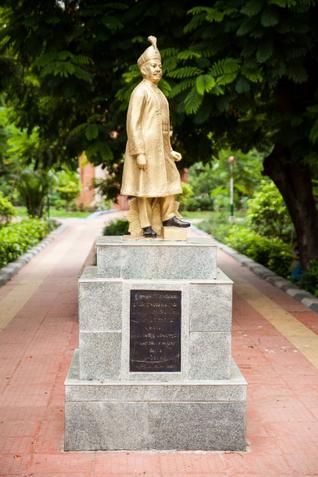
The statue of the Raja of Panagal (actually Paanagal) stands inside the park in T. Nagar that is named after him. It is usually the starting point for my T. Nagar Heritage Walk. It was during one of these that I happened to meet MVS Appa Rao, one of the great grandsons of the Raja. And it was through him that I came to know that July 9 this year will mark the 150th birth anniversary of the king who became Chief Minister.
Panaganti Ramarayaningar was born into an aristocratic family of Kalahasti. A polyglot, he completed his matriculation from the Hindu High School, Triplicane, in 1886. He then did his BA at the Presidency College, Madras, and obtained his MA from the University of Madras in 1899. In between, he also acquired a BL degree from the Law College, Madras.
His life of public service began with his being selected as Member, North Arcot District Board. In 1912, he became a member of the Imperial Legislative Council in Delhi, where his debating skills and intellect came to the notice of the Viceroy, Lord Hardinge of Penshurst. In 1918, he was awarded the title of Dewan Bahadur. He was also made a member of the Imperial War Council the same year.
Back in Madras meanwhile, the non-Brahmin movement had gained momentum, with the formation of the Justice Party. Ramarayaningar joined it and was soon recognised as one of its leading lights. He was sent to England to depose before a Parliamentary Committee on the condition of the non-Brahmins in South India. In 1920, Madras Presidency saw its first democratic Government, albeit on a limited franchise. The First Minister, equivalent to today’s Chief Minister, was A. Subbarayalu Reddiar, who stepped down six months later, citing ill health.
Ramarayaningar succeeded him. His Government was returned to office in 1923, with a comfortable majority. He was given the honorific of the Raja of Panagal the same year. However, the Justice Party lost in 1926 and the Raja became the leader of the Opposition. He was knighted that year.
The Panagal administration was known for some far-reaching reforms. Reservation in Government jobs was brought in, thereby putting Madras on the route to inclusivity. The administration of temples and mutts came under a newly-formed Hindu Religious Endowments Board. A School for Indian Medicine was set up, the Raja giving his property, Hyde Park Gardens, Kilpauk, for it. The Kilpauk Medical College is now in that campus. Work also began on the laying out of Thyagaraya Nagar as a residential area.
Panagal passed away on December 16, 1928, at Madras. His statue in the park, by M.S. Nagappa, used to be relegated to a corner till a decade back, with a mutilated bust of King George V occupying centre stage. Happily, the bust has since been removed and the Raja placed in a prominent position. Unfortunately, whoever did that also gave the wonderful bronze a coat of gilt.
source: http://www.thehindu.com / The Hindu / Home> Metroplus> Society / by Sriram V / Chennai – July 01st, 2016